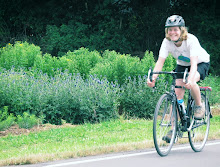Of course, some developers talk about "sustainable development" (a puzzling little oxymoron) or planning for "livability". They throw in a few bike paths and extra trees. Still, these greenwashing tactics don't solve the root problems of urban sprawl: isolation of communities and the destructin of ecologically valuable unpaved land that has the added benefit of keeping the population fed.
Thanks to rural land speculation and the cycle of decline in inner cities, this pattern of development has been difficult to stop or even slow, although the present recession is helping immensely. Still, the sight of sprawling asphalt and rows of single-family dwellings from an airplane window has the power to throw me into a funk of hopelessness for days.
But wait! Could there be a slow shift in consciousness here? I was recently mailed an article (the old-fashioned way, no less) describing the hottest trend in housing developments: organic farms. And I don't mean developers are buying out farmers and naming the subdivisions "Pesticide-Free Strawberry Fields" instead of "Shady Oak Glen". No, according the New York Times article, farms are now considered "subdivision amenities" by many developers. Instead of building homes around golf courses, they are putting in organic farms to draw in yuppie foodies or perhaps those who have ideas about living in a rural area. Residents can even pitch in around the farm and share in the harvest. Of course, the article left out some of the potential difficulties that immediately come to mind. What happens when the breeze shifts and some unfortunate homeowner realizes they've purchased the olfactory privilege of living downwind from the chicken house? Will residents tolerate the drone of a tractor disturbing the peaceful summer ambiance?
Thanks to rural land speculation and the cycle of decline in inner cities, this pattern of development has been difficult to stop or even slow, although the present recession is helping immensely. Still, the sight of sprawling asphalt and rows of single-family dwellings from an airplane window has the power to throw me into a funk of hopelessness for days.
But wait! Could there be a slow shift in consciousness here? I was recently mailed an article (the old-fashioned way, no less) describing the hottest trend in housing developments: organic farms. And I don't mean developers are buying out farmers and naming the subdivisions "Pesticide-Free Strawberry Fields" instead of "Shady Oak Glen". No, according the New York Times article, farms are now considered "subdivision amenities" by many developers. Instead of building homes around golf courses, they are putting in organic farms to draw in yuppie foodies or perhaps those who have ideas about living in a rural area. Residents can even pitch in around the farm and share in the harvest. Of course, the article left out some of the potential difficulties that immediately come to mind. What happens when the breeze shifts and some unfortunate homeowner realizes they've purchased the olfactory privilege of living downwind from the chicken house? Will residents tolerate the drone of a tractor disturbing the peaceful summer ambiance?
Apparently, somebody has figured out a way to make it work, because the developments do seem to have caught on. They probably won't work everywhere - not all sprawl takes place on pristine farmland with ample water - and they certainly don't cure the basic problems inherent in urban sprawl mentioned above, but I suppose if people must live in subdivisions, they might as well have a convenient, safe food source nearby. The logical next steps will be to put in a school, a few small, locally owned stores and restaurants, and public gathering spaces, eliminating the need to drive thirty minutes for a coffee fix or a new rake. Put it all together, and a sprawling city will have devolved into a cluster of small towns. Livability? Absolutely. Eat-ability? Even better.




No comments:
Post a Comment